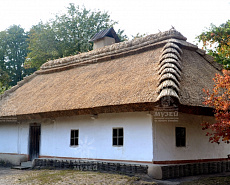Хата із села Шевченкове Звенигородського району Черкаської області
Будівля перевезена з батьківщини Тараса Григоровича Шевченка. Вона належала онуку Тараса Шевченка по брату Микиті – Тимошу (Тимофію) Петровичу Шевченку (1870–1954). Він був мірошником, мав свій млин. До 1973 року в ній жила його родина.
Хата тридільна (хата, сіни, комора), зведена на дубових сохах, закладених «у заміт» дубовими брусами. Угорі сохи обв’язані ощіпом у два вінці, у які закладено дошки стелі, що спираються на поздовжній митий сволок. Під ним – поперечний сволок, що використовується як полиця. Сіни без стелі, з двома дверима на обидва двори. Навколо стін хати широка глинобитна призьба, обкладена дошками, мащена рудою глиною із червоною підводкою. Дах чотирисхилий, на кроквах, критий солом’яними парками по латах, з «китицями» на наріжниках та накладним гребенем.
Найбільш освітлений і прикрашений у хаті куток – покуть, де висять ікони, стоїть стіл. Це найбільш почесне місце за столом: сюди садовили найдорожчого серцю гостя, а під час весілля на вивернутому кожусі – молодих. Під час обіду на покуті мав право сидіти дід чи батько. На покуть ставили пікну (хлібну) діжу, а на різдвяні свята – кутю та дідуха. Ікони покривали вишитими, домотканими чи купованими рушниками, ними прикрашали хату у свята. Традиційні орнаментальні мотиви на рушниках вважалися оберегами, які захищали житло від невидимих злих сил.
На жердці – сорочки, керсетки та інше вбрання. Стіл і скриня застелені домотканим килимом. У миснику представлений мальований череп’яний посуд із давніх гончарних осередків – сіл Гнилець Звенигородського району та Дибинці Богуславського району Київської області.
В інтер’єрі є два музичні інструменти: кобза й ліра. Мандрівні музиканти із цими інструментами подорожували селами та містечками, зупиняючись і граючи на майданах, ярмарках, біля церков та монастирів, рідше – у сільських хатах. Суспільна роль таких музикантів, які виконували історичні епоси (балади, думи), релігійну музику тощо, була яскравою і визнаною. Ці люди були необхідним елементом ритуального життя села: чи то в подіях, що відбувалися згідно з календарем, чи то в подіях родинного життя.
Хата, комора й погрібник розташовані на чистому дворі. На господарському дворі розміщені повітка і хлів із повіткою.
Хата тридільна (хата, сіни, комора), зведена на дубових сохах, закладених «у заміт» дубовими брусами. Угорі сохи обв’язані ощіпом у два вінці, у які закладено дошки стелі, що спираються на поздовжній митий сволок. Під ним – поперечний сволок, що використовується як полиця. Сіни без стелі, з двома дверима на обидва двори. Навколо стін хати широка глинобитна призьба, обкладена дошками, мащена рудою глиною із червоною підводкою. Дах чотирисхилий, на кроквах, критий солом’яними парками по латах, з «китицями» на наріжниках та накладним гребенем.
Найбільш освітлений і прикрашений у хаті куток – покуть, де висять ікони, стоїть стіл. Це найбільш почесне місце за столом: сюди садовили найдорожчого серцю гостя, а під час весілля на вивернутому кожусі – молодих. Під час обіду на покуті мав право сидіти дід чи батько. На покуть ставили пікну (хлібну) діжу, а на різдвяні свята – кутю та дідуха. Ікони покривали вишитими, домотканими чи купованими рушниками, ними прикрашали хату у свята. Традиційні орнаментальні мотиви на рушниках вважалися оберегами, які захищали житло від невидимих злих сил.
На жердці – сорочки, керсетки та інше вбрання. Стіл і скриня застелені домотканим килимом. У миснику представлений мальований череп’яний посуд із давніх гончарних осередків – сіл Гнилець Звенигородського району та Дибинці Богуславського району Київської області.
В інтер’єрі є два музичні інструменти: кобза й ліра. Мандрівні музиканти із цими інструментами подорожували селами та містечками, зупиняючись і граючи на майданах, ярмарках, біля церков та монастирів, рідше – у сільських хатах. Суспільна роль таких музикантів, які виконували історичні епоси (балади, думи), релігійну музику тощо, була яскравою і визнаною. Ці люди були необхідним елементом ритуального життя села: чи то в подіях, що відбувалися згідно з календарем, чи то в подіях родинного життя.
Хата, комора й погрібник розташовані на чистому дворі. На господарському дворі розміщені повітка і хлів із повіткою.

